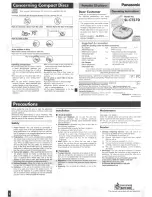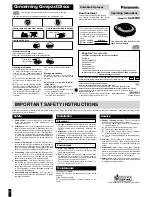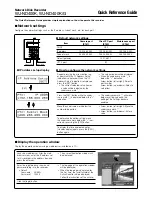
Keep this operating instruction close
by the machine, protected from dirt
and humidity, and pass it over to the
new owner if you part with the tool.
No changes to the machine may be
made.
Daily inspect the function and
existence of the safety appliances
before you start the machine.
Do not attempt operation in this case,
protect the machine by unplugging the
mains cord.
Remove all loose clothing and confine
long hair.
Before operating the machine, remove
tie, rings, watches, other jewellery, and
roll up sleeves above the elbows.
Wear safety shoes; never wear leisure
shoes or sandals.
Always wear the approved working
outfit
Do
not
wear gloves while operating
this machine.
Control the stopping time of the
machine, it may not be longer than 10
seconds.
Remove cut and jammed workpieces
only when motor is turned off and the
machine is at a complete standstill.
Install the machine so that there is
sufficient space for safe operation and
workpiece handling.
Keep work area well lighted.
The machine is designed to operate in
closed rooms and must be placed
stable on firm and levelled ground.
Make sure that the power cable does
not impede work and cause people to
trip.
Keep the floor around the machine
clean and free of scrap material, oil
and grease.
Stay alert!
Give your work undivided attention.
Use common sense. Do not operate
the machine when you are tired.
Do not operate the machine under the
influence of drugs, alcohol or any
medication. Be aware that medication
can change your behaviour.
Never reach into the machine while it
is operating or running down.
Never leave a running machine
unattended. Before you leave the
workplace switch off the machine.
Keep children and visitors a safe
distance from the work area.
Do not operate the electric tool near
inflammable liquids or gases.
Observe the fire fighting and fire alert
options, for example the fire
extinguisher operation and place.
Do not use the machine in a dump
environment and do not expose it to
rain.
Wood dust is explosive and can also
represent a risk to health.
Dust form some tropical woods in
particular, and from hardwoods like
beach and oak, is classified as a
carcinogenic substance.
Always use a suitable dust extraction
device
Before machining, remove any nails
and other foreign bodies from the
workpiece.
Never operate with the guards not in
place – serious risk of injury!
All anti-kickback fingers must
automatically return to their rest
position (downwards)
Never reach with your hands into the
machine when guiding or sorting the
workpiece.
Use a feeding aid (push wood) if you
want to feed short stock into the
machine. Stock must have a minimum
length of 250mm.
Specifications regarding the maximum
or minimum size of the workpiece must
be observed.
Do not remove chips and workpiece
parts until the machine is at a complete
standstill.
Always use sharp cutter knives.
Do not machine more than two
workpieces at the same time.
To plane stock which surfaces are not
parallel, use suitable feeding aids
(make fitting templates).
Use roller supports on both sides of
the planer when working long stock.
Keep planer bed surface clean, in
particular remove resin residue.
Connection and repair work on the
electrical installation may be carried
out by a qualified electrician only.
Have a damaged or worn cord
replaced immediately.
Make all machine
adjustments or
maintenance with the
machine unplugged from
the power source.
3.3 Remaining hazards
When using the machine according to
regulations some remaining hazards
may still exist
Touching the cutter block in the
machining area can cause injury.
Drawing-in/trapping hazard by power
feed mechanism.
Squeezing hazard by workpiece
power-outfeed.
Thrown workpiece parts can lead to
injury
Sawdust and noise can be health
hazards. Be sure to wear personal
protection gear such as safety goggles
and ear protection. Use a suitable dust
exhaust system.
The use of incorrect mains supply or a
damaged power cord can lead to
injuries caused by electricity.
4. Machine specifications
4.1 Technical data
Planing width
max 318 mm
Planing thickness
6 to 153 mm
Depth of cut
max. 2,5 mm
Number of knives
2
Cutterhead diameter
48 mm
No-load speed n
o
9000
rpm
Cuts per minute
18000
Cutter knife length
319mm
Cutter knife width
18mm
Cutter knife thickness
3mm
Feed rate
7 m/min
Weight 27
kg
Mains
230V ~1L/N/PE 50-60Hz
Motor input power
2000W
Reference current
9 A
Extension cord
H05W-F 3G1mm²
Installation fuse protection
16A
4.2 Noise emission
Determined according to EN 1807:1999
(Inspection tolerance 4 dB)
Acoustic power level (acc. EN 3746):
Idling
101,5 dB (A)























